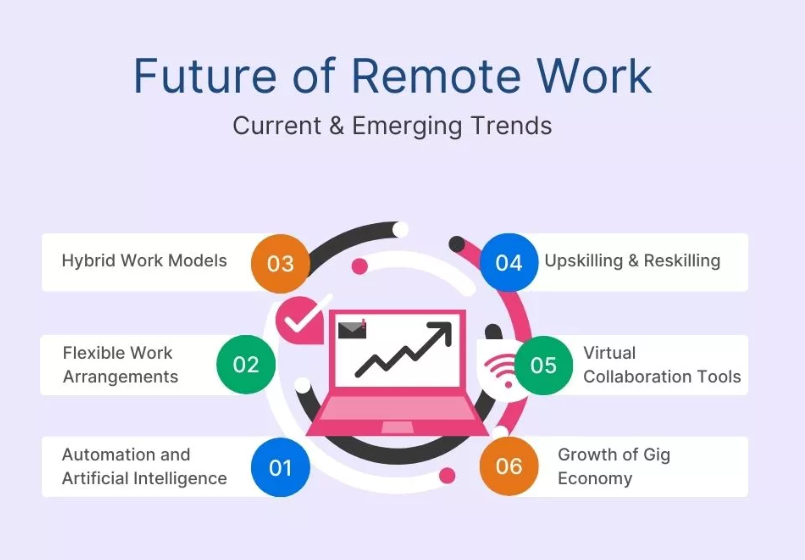The Future of Work: Top Remote Tools and Platforms Transforming Productivity in 2025
Remote work has continued to evolve rapidly in 2025, with a surge in advanced tools and platforms designed to boost productivity, streamline collaboration, and support hybrid and fully distributed teams. This article delves into the leading trends, platforms, and tools that are shaping the future of remote work.
Evolution of Remote Work
The evolution of remote work has been a gradual yet transformative journey, shaped by technological breakthroughs and societal changes. Before the digital age, remote work was rare, limited to professions like sales or consulting that required travel. The advent of email and early collaboration tools in the 1990s laid the groundwork, but connectivity and infrastructure limitations kept it niche. The 2000s saw the rise of cloud computing and video conferencing, enabling more flexible work arrangements, yet adoption remained slow due to cultural resistance.
The COVID-19 pandemic in 2020 acted as a catalyst, forcing businesses worldwide to adopt remote work overnight. Tools like Zoom, Slack, and Microsoft Teams became household names, proving that productivity could thrive outside traditional offices. This period also exposed gaps in security, collaboration, and work-life balance, driving rapid innovation. By 2025, remote work has matured beyond crisis response into a strategic advantage.
Technological advancements like 5G networks, AI-driven productivity suites, and immersive VR workspaces have eliminated early barriers. Societal shifts, including the demand for work flexibility and the globalization of talent, have cemented remote work as a permanent fixture. Companies now prioritize digital-first strategies, leveraging decentralized teams to tap into global expertise while reducing overhead costs. The transition from necessity to norm reflects a deeper change in how we define work—one where location is no longer a constraint but an opportunity.
As we look ahead, the lessons of this evolution inform the current landscape, where hybrid models and intelligent tools redefine productivity. The next chapter will explore how these trends are shaping workflows in 2025.
Current Landscape and Major Trends in Remote Work
The remote work landscape in 2025 is defined by a seamless integration of hybrid models, AI-driven automation, and next-gen collaboration tools. Companies no longer debate whether to adopt remote work but focus on how to optimize it. Hybrid work has matured beyond a temporary solution into a structured framework, with employees splitting time between home offices and coworking hubs. AI scheduling assistants now dynamically allocate in-office days based on team project needs, minimizing commute times while preserving face-to-face collaboration.
Automation has become indispensable, with AI handling repetitive tasks like data entry, meeting transcriptions, and even preliminary project management. Platforms leverage predictive analytics to flag workflow bottlenecks before they disrupt productivity. Meanwhile, enhanced collaboration tools have evolved beyond video calls. Virtual whiteboards with real-time AI summarization, 3D spatial audio for immersive meetings, and emotion-sensing avatars bridge the gap between physical and digital presence. These tools are no longer novelties—they’re embedded in daily workflows, reducing fatigue and fostering spontaneity.
Culture has adapted too. Asynchronous communication is the norm, with AI-powered chatbots managing time-zone disparities by prioritizing urgent messages. Companies invest in digital culture builders, like VR team retreats and AI-curated social spaces, to combat isolation. The rise of outcome-based performance metrics over hourly tracking reflects this shift, empowering employees to design their most productive schedules.
The result? A workforce that’s more flexible, efficient, and globally connected than ever—setting the stage for the platforms enabling this transformation, as explored in the next chapter.
Leading Remote Work Platforms
In 2025, remote work platforms like Crossover, FlexJobs, and Himalayas have become pivotal in reshaping how organizations source, manage, and retain global talent. These platforms go beyond traditional job boards by integrating advanced AI-driven matching algorithms, ensuring precise alignment between remote professionals and employers based on skills, cultural fit, and project requirements.
Crossover stands out with its focus on high-performance remote roles, particularly in tech and executive positions. Its proprietary work intelligence system tracks productivity metrics in real-time, offering employers transparency while empowering workers with performance-based incentives. The platform also enforces structured workflows, reducing the friction of asynchronous collaboration across time zones.
FlexJobs, a veteran in the remote work space, has evolved into a hybrid talent marketplace. It curates verified remote and hybrid opportunities while providing upskilling resources tailored to in-demand roles. Its SmartMatch feature leverages machine learning to recommend jobs based on a candidate’s historical applications and employer feedback, streamlining the hiring process.
Meanwhile, Himalayas has carved a niche with its emphasis on transparency and community. Unlike conventional platforms, it displays salary ranges, company reviews, and remote policies upfront, fostering trust. Its Talent Cloud aggregates freelancers and full-time remote workers, allowing companies to build dynamic teams for short- or long-term projects.
Together, these platforms address critical gaps in remote talent acquisition:
- Efficiency: AI reduces time-to-hire by automating candidate screening.
- Quality: Rigorous vetting ensures access to top-tier global talent.
- Flexibility: Scalable workforce solutions cater to fluctuating project demands.
By 2025, their role extends beyond job matching—they are ecosystems fostering remote work culture, enabling companies to thrive in a borderless labor market.
Communication and Collaboration Tools
As remote work becomes the norm in 2025, communication and collaboration tools like Slack, Zoom, and Teamly have evolved to address the unique challenges of distributed teams. These platforms are no longer just about messaging or video calls—they now integrate advanced features to bridge the gap between asynchronous and real-time collaboration, ensuring seamless workflows across time zones and cultures.
Slack has transformed into a centralized hub for team interactions, leveraging AI to prioritize messages, automate routine responses, and even suggest relevant channels based on project needs. Its deep integrations with other productivity tools allow teams to manage workflows without switching apps, reducing context-switching fatigue. Meanwhile, Zoom has expanded beyond video conferencing with immersive virtual workspaces, where teams can collaborate in 3D environments, share interactive whiteboards, and even use AI-powered transcription for multilingual meetings.
Emerging platforms like Teamly combine the best of both worlds, offering threaded discussions, task delegation, and real-time document collaboration in a single interface. Its predictive analytics help managers identify communication bottlenecks, while its sentiment analysis tools gauge team morale, enabling proactive adjustments to remote work dynamics.
Key advancements in these tools include:
- AI-driven noise suppression for clearer audio in hybrid meetings.
- Context-aware chatbots that fetch project details or schedule follow-ups mid-conversation.
- Automated meeting summaries with action items extracted from discussions.
These innovations ensure that remote teams stay aligned, engaged, and productive, setting the stage for the next frontier: AI-powered project management solutions that further streamline remote workflows.
Project and Task Management Solutions
As remote work continues to evolve in 2025, project and task management tools like Monday.com, Trello, and Asana have become indispensable for distributed teams. These platforms have transformed beyond simple task tracking, integrating AI-driven automation and advanced analytics to streamline workflows and enhance visibility. Unlike communication tools, which focus on real-time interaction, these solutions prioritize structured task delegation, progress tracking, and resource allocation—critical for remote teams lacking physical oversight.
Monday.com stands out with its customizable dashboards and AI-powered workload balancing, ensuring no team member is overburdened. Its predictive analytics help managers identify bottlenecks before they escalate, fostering proactive adjustments. Meanwhile, Trello leverages visual Kanban boards enhanced by AI-driven suggestions for task prioritization, making it ideal for agile teams. The platform’s automation features, like smart due-date adjustments, reduce manual input, freeing up time for strategic work.
Asana takes collaboration deeper with AI-assisted project timelines that adapt dynamically to changes. Its “Smart Goals” feature aligns individual tasks with broader objectives, ensuring remote teams stay focused on high-impact work. All three platforms now offer real-time integrations with communication tools like Slack and Zoom, bridging the gap between task execution and team discussions.
The impact of these tools is clear: they minimize misalignment, automate repetitive processes, and provide granular insights into project health. For remote teams, this translates to higher accountability, reduced micromanagement, and a seamless workflow—laying the groundwork for the next chapter’s focus on time tracking and productivity tools, which further refine these efficiencies.
Productivity and Time Management Tools
In the evolving landscape of remote work, productivity and time management tools like Clockify have become indispensable for maintaining efficiency and accountability. Unlike project management platforms, which focus on task delegation and workflow coordination, time-tracking tools provide granular insights into how remote teams allocate their hours, ensuring optimal productivity and transparency.
Clockify stands out for its simplicity and scalability, offering features like automatic time tracking, detailed reporting, and integration with other remote work tools. By capturing work hours in real-time, it eliminates guesswork and helps teams identify inefficiencies. For remote workers, this means better self-regulation, as they can analyze time spent on tasks and adjust workflows accordingly. Managers, on the other hand, gain visibility into team productivity without micromanaging, fostering trust in distributed environments.
One of Clockify’s most transformative aspects is its role in project timeline tracking. By correlating time logs with project milestones, teams can forecast deadlines more accurately and allocate resources efficiently. AI-powered analytics further enhance this by detecting patterns—such as recurring time drains—and suggesting improvements.
As remote work continues to evolve, the demand for tools that bridge productivity gaps will grow. Clockify and similar platforms address a critical need: ensuring that time, the most finite resource in remote work, is used effectively. This seamless integration of tracking and analytics complements the project management solutions discussed earlier while setting the stage for the next frontier—content and information management—where organized workflows depend on disciplined time use.
Content and Information Management
In the evolving landscape of remote work, content and information management tools have become indispensable for maintaining productivity. As remote teams juggle vast amounts of digital content—from emails to interactive documents—platforms like Clean Email and FlippingBook streamline workflows by decluttering inboxes and enhancing digital content sharing.
Clean Email tackles one of the biggest productivity killers: email overload. By automating inbox organization, filtering spam, and bundling similar messages, it ensures remote workers spend less time sifting through clutter and more time on high-value tasks. Features like Smart Folders and Unsubscribe Assistant reduce distractions, allowing professionals to focus on critical communications.
Meanwhile, FlippingBook revolutionizes how teams share digital content. Transforming static PDFs into interactive, web-based publications, it enhances engagement and collaboration. Remote workers can embed videos, track reader analytics, and even collect feedback—making it ideal for client proposals, training materials, or reports.
Effective information management is critical for remote teams to stay organized. Without the structure of a physical office, digital tools must compensate by:
- Reducing cognitive load by automating repetitive tasks like email sorting.
- Enhancing accessibility through cloud-based, searchable content repositories.
- Improving collaboration with interactive, real-time document sharing.
As remote work grows more complex, these tools bridge the gap between scattered digital assets and seamless productivity. They complement time-tracking solutions discussed earlier by minimizing distractions, while setting the stage for AI-driven automation—where intelligent systems will further refine how information is processed and shared. The future of remote productivity hinges on mastering these layers of efficiency.
AI and Automation as the Productivity Multipliers
AI and automation have emerged as the backbone of remote work productivity, seamlessly integrating into tools to eliminate repetitive tasks and amplify efficiency. In 2025, these technologies are no longer optional—they are essential for remote teams striving to maintain competitive workflows.
Scheduling and Calendar Management has been revolutionized by AI-driven assistants like Clockwise and Reclaim. These tools analyze individual and team calendars to automatically optimize meeting times, block focus hours, and even reschedule low-priority tasks. By reducing manual coordination, teams reclaim hours once lost to administrative overhead.
Meeting Summaries and Note-Taking are now handled by AI-powered platforms such as Otter.ai and Fireflies. These tools transcribe conversations in real-time, extract action items, and generate concise summaries—ensuring no critical detail slips through the cracks. Remote workers spend less time reviewing recordings and more time executing decisions.
Workflow Optimization is where automation truly shines. Tools like Zapier and Make (formerly Integromat) connect disparate applications, automating data transfers and repetitive processes. For instance, a Slack message can trigger a Trello task, which then updates a Google Sheet—all without human intervention. AI-enhanced project management platforms like ClickUp and Asana predict bottlenecks and suggest adjustments, keeping teams agile.
The integration of AI into these tools doesn’t just streamline tasks—it transforms how remote teams operate. By offloading cognitive load to machines, professionals focus on high-value work, fostering innovation rather than drowning in logistics. As we transition into discussing remote work challenges, it’s clear that AI and automation are not just solving problems—they’re redefining what’s possible.
Addressing Key Challenges with Remote Work Tools
Remote work has unlocked unprecedented flexibility, but it also introduces challenges that can hinder productivity if not addressed effectively. Communication barriers, project management complexities, and accurate time tracking remain persistent pain points for distributed teams. Fortunately, emerging tools and platforms in 2025 are designed to tackle these issues head-on, ensuring seamless collaboration regardless of location.
Communication barriers often arise from asynchronous workflows and lack of real-time context. Platforms like Slack and Microsoft Teams now integrate AI-powered contextual suggestions, reducing miscommunication by predicting responses and flagging ambiguities. Video conferencing tools such as Zoom and Google Meet leverage real-time transcription and sentiment analysis to enhance engagement, while spatial audio mimics in-person conversations for more natural interactions.
Project management becomes fragmented when teams span multiple time zones. Advanced platforms like Asana and ClickUp now feature AI-driven task prioritization, automating dependency mapping and adjusting deadlines dynamically based on team capacity. Trello has introduced smart boards that visualize bottlenecks and suggest redistributions, ensuring smoother workflows.
Time tracking remains critical for accountability and productivity. Tools like Harvest and Clockify now use AI to categorize activities automatically, distinguishing between productive work and distractions. Some platforms even integrate with biometric wearables to analyze focus patterns and recommend optimal work intervals.
By addressing these challenges with intelligent, adaptive solutions, remote work tools in 2025 are not just maintaining productivity—they’re elevating it. As these technologies evolve, they bridge the gap between physical distance and seamless collaboration, setting the stage for the next phase of remote work innovation.
The Future Outlook of Remote Work
The future outlook of remote work beyond 2025 is poised to be shaped by a convergence of technological innovation, cultural shifts, and global workforce dynamics. As remote and hybrid models become deeply ingrained in organizational structures, advancements in AI, augmented reality (AR), and decentralized work platforms will redefine productivity and collaboration.
One key trend will be the rise of AI-driven virtual workspaces, where intelligent assistants handle scheduling, task prioritization, and even real-time language translation, eliminating friction in global teams. Platforms like VR meeting spaces will evolve beyond basic video calls, offering immersive 3D environments that simulate in-person interactions, complete with spatial audio and gesture-based controls.
The workforce itself will become more fluid, with gig-based and project-centric roles dominating. Decentralized autonomous organizations (DAOs) and blockchain-based platforms will enable trustless contracts, ensuring seamless collaboration across borders without traditional intermediaries. Tools for skills-based matching will replace rigid job titles, allowing professionals to contribute dynamically to multiple projects.
Cultural norms will also shift toward outcome-based evaluations, reducing reliance on rigid schedules. Companies will invest in wellness-integrated tools, using biometric feedback to prevent burnout and optimize productivity. Meanwhile, governments may introduce policies to standardize remote work rights, addressing disparities in access to high-speed internet and digital infrastructure.
By 2030, the line between remote and in-office work may blur entirely, with hybrid models becoming the default rather than the exception. The challenge will lie in balancing human-centric design with automation—ensuring technology enhances, rather than replaces, meaningful human connection in the workplace. The future of work isn’t just remote; it’s adaptive, intelligent, and borderless.

Conclusions
The landscape of work in 2025 is markedly characterized by the extensive adoption of flexible, AI-enhanced hybrid work models. Tools and platforms such as Slack, Zoom, Monday.com, and a range of innovative job boards are central to promoting productivity and employee satisfaction, pushing companies and individuals towards a more digital-first working environment.



